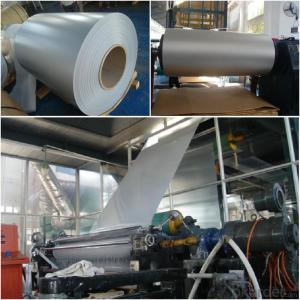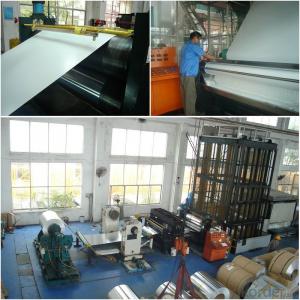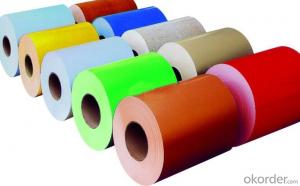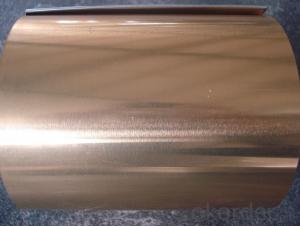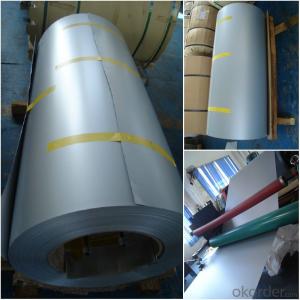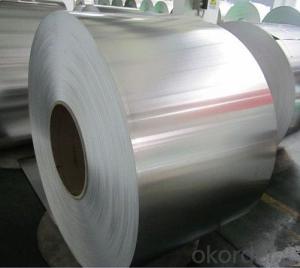Aluminum Coil Anodizing Company - PE Silver Color Coated Aluminum Rolls
- Loading Port:
- China Main Port
- Payment Terms:
- TT OR LC
- Min Order Qty:
- -
- Supply Capability:
- -
OKorder Service Pledge
OKorder Financial Service
You Might Also Like
Colorcoated aluminum magnesium alloy Al-Mn
Second, the Al-Mn-Mg alloys thecharacteristics of color coated aluminum
Color coated aluminum magnesiumalloy Al-Mn alloy is used for the 3004 state of the Al-Mn-Mg aluminum alloysubstrate, after de-ester, cleaning, passivation layer processing, and thenpainting on this basis, the international most advanced level of KANAR500 andHYLAR5000 Series Fluorocarbon (PVDF) resin coating, the color coated aluminummanganese alloy known international companies use the U.S. PPG, Sweden and theUnited States Weishi Bo Beca companies paint company, its products by thenatural light exposure, Florida testing, with more than 20 years of weatheringquality assurance. Color coated aluminum magnesium alloy Al-Mn advantages ofraw materials, its products have a high strength, corrosion resistance, highweather resistance and other characteristics, and according to their owncustomers were asked to choose a different color palette, you can colorintegration, can co-exist to gorgeous effect.
Third, Al-Mn-Mg alloys the useof color coated aluminum
Our company specializes inaluminum color coated aluminum manganese alloy has been widely used in largefactories, exhibition halls, stadiums, airports, train station roof and ceilingdecorative envelope system board. Thickness of the aluminum can choosedifferent color coated aluminum magnesium alloy of manganese, by cutting,pressing, punching, bending and other follow-up molding process for large span,the larger the overall roof, wall decorative panels used in construction; Youcan also cut into small panels by bending, stamping mold, etc., for indoordecorative roof plate; also with polyurethane foam, bonded aluminum honeycombcomposite construction for energy-saving decorative wall plates.
Fourth, the development prospects
As the field of buildingdecoration materials, the continuous improvement requirements, as poorperformance of color coated steel corrosion, rust, yellow rust after a largeamount of the deficiency of serious impact on the building's overallappearance, the urgent need to develop a color plate with both strength, butalso overcome the shortcomings of color-coated steel, while there are long-termdurability of new materials, building decoration, used in airports, commercialbuildings, train stations, subways, hospitals and other architecturaldecoration. The Al-Mn-color coated aluminum magnesium alloy materials preciselymeet these requirements, with the expanding domestic demand, strengthen publicinfrastructure under the principle of color coated aluminum magnesium alloy ofmanganese will become an increasingly widespread use of aluminum, a goodprospect.
PEAluminum Coating Coils for ACP
Features of PE Aluminum Sheet:
1. Adopting precision rolling coatingtechnology, our PVDF and PE coated coil can ensure excellent adhesive withoutcoating omission.
2. For the PE coated aluminum coil weproduced, there are various colors for your choice.
3. Using infrared heating technology toprotect environment from pollution.
4. Our coated aluminum coil has four-rollercoating line, uniform coating thickness and good features.
RawMaterial of the PE Aluminum Coating Coils:
1.Aluminum Coil: high strength aluminum with alloy of AA1100 (aluminum alloy isavailable with AA3003, AA3005, AA5005 according to customer)
2. SurfacePaint: PE, PVDF and special paints.
Specificationof PE Aluminum Coating Coil
Width:20mm~1590mm
Thickness:0.06mm~1.0mm
ExternalDiameter: ≤ 1500mm
InternalDiameter: 405mm, 505mm, 150mm, 75mm
Coilweight: ≤ 4000kg
PE coatedaluminum coil is processed through the technics of roller coating and bakingwith precise polyester paints. Its color is glossy and with variety of colorsenabling you to choose easily. Chromatic aberration is small, impact resistanceis strong and easy to be processed, and all its performance has reached orsurpassed the national criteria. The products are widely used in indoor anddoor decoration, ceilings, room surface tiles, corrugated boards, wall panels, advertisement boards, counters,home appliances, decoration in and out of autos and boats.
Performanceof the coating
Aluminum Thickness | Coating Thickness | MEK | T- Bend | Impact | Adhesion | Pencil Hardness | Boiling Water Proof |
0.3-1.5mm | ≥18μm | ≥100 Times | ≤2T | 50 kg•cm | 0 Grade | ≥HB | no change within 2 hours |
0.2-0.28mm | ≥18μm | ≥100 Times | ≤2T | 30kg•cm | 0 Grade | ≥HB | no change within 2 hours |
0.15-0.18mm | ≥18μm | ≥100 Times | ≤3T | 20 kg•cm | 0 Grade | ≥HB | no change within 2 hours |
0.08-0.12mm | ≥16μm | ≥80 Times | ≤4T | 10 kg•cm | ≤1 Grade | ≥HB | no change within 1 hour |
0.022-0.06mm | ≥12μm | ≥50 Times | - | - | ≤1Grade | ≥HB | no change within1 hour |
Colorof Card
PE (polyester)
PE
ColorMatch
For custom' color requests, we can deal as following:
1. Supply a physical sample of custom color. A color sample on metal ispreferred. If other, it is also acceptable. But the color matching rate may benot good as color on metal.
2. New color sample is usually offered by our paint supplier in 5-7 days,special color should be in 7-10 days.
3. Upon receipt of color sample, please approve in writing as soon as possible.Once you approved, we will arrange purchasing and production.
Note: Color difference maybe occurred in different production batch, so it issuggested all panels are placed in one order for same project. And keep samedirection as arrow on protective film when installing to avoid any colordifference by vision
- Q: Are aluminum coils suitable for decorative applications?
- Indeed, decorative applications can benefit greatly from the use of aluminum coils. This versatile and lightweight material boasts exceptional corrosion resistance, rendering it an optimal selection for decorative purposes. Its ability to be effortlessly shaped, formed, and fabricated into a myriad of designs, patterns, and finishes grants endless possibilities in the realm of decoration. Furthermore, aluminum coils can be coated with various colors and finishes, including anodized or painted coatings, to augment both their aesthetic allure and durability. Thus, whether utilized for interior or exterior decoration, the utilization of aluminum coils offers a visually captivating and economically viable solution.
- Q: What is the difference between hot-rolled and cold-rolled aluminum coils?
- The manufacturing process and resulting properties of the finished product differentiate hot-rolled and cold-rolled aluminum coils. Hot-rolled coils are made by subjecting aluminum ingots to high temperatures and passing them through rollers to achieve the desired thickness and shape. This process enhances the aluminum's malleability and allows for greater flexibility in terms of size and shape. Hot-rolled coils are generally larger and have a rougher surface finish compared to cold-rolled coils. In contrast, cold-rolled coils are produced by cooling down the hot-rolled coils and passing them through rollers at room temperature. This not only reduces the thickness of the aluminum but also improves its surface finish, resulting in a smoother and more pleasing appearance. Cold-rolled coils are typically thinner and have a more consistent thickness compared to their hot-rolled counterparts. The differences in the manufacturing process and surface finish of these two types of coils lead to distinct mechanical properties. Hot-rolled coils are generally weaker and have lower tensile strength when compared to cold-rolled coils. However, they are more ductile and can be easily formed and shaped without cracking. On the other hand, cold-rolled coils possess higher tensile strength and are better suited for applications that require increased strength and durability. To summarize, hot-rolled aluminum coils are larger, have a rougher surface finish, and are more malleable. In contrast, cold-rolled aluminum coils are thinner, have a smoother surface finish, and are stronger. The choice between hot-rolled and cold-rolled coils depends on the specific requirements of the application, such as strength, surface finish, and formability.
- Q: How are aluminum coils joined or welded?
- Aluminum coils can undergo various methods of joining or welding, depending on the specific application and desired outcome. Some commonly employed techniques are: 1. Mechanical fastening: This involves physically fastening the aluminum coils together using bolts, screws, or rivets. Mechanical fastening is a cost-effective and straightforward method suitable for thin coils or temporary connections. 2. Adhesive bonding: Specialized adhesives are used to bond aluminum coils together in adhesive bonding. This method creates a strong and durable joint, evenly distributing stress across the entire bond area. Adhesive bonding is often used when aesthetics, weight reduction, or vibration dampening are important considerations. 3. Resistance welding: Resistance welding employs an electric current to generate heat and pressure at the joint, effectively welding the aluminum coils. This method is particularly suitable for high-speed production lines, providing a strong and reliable joint. However, it requires specialized equipment and may not be suitable for all aluminum alloys. 4. Laser welding: Laser welding is a precise and efficient method that utilizes a laser beam to melt and join the aluminum coils. This technique allows for precise control of heat input, resulting in minimal distortion and excellent weld quality. Laser welding is commonly used in industries where high precision and aesthetic appearance are crucial, such as automotive and aerospace. 5. Friction stir welding: Friction stir welding is a solid-state joining process that employs a rotating tool to generate heat and friction, effectively welding the aluminum coils without melting the material. This method produces strong and high-quality welds with minimal distortion and no need for additional filler material. Friction stir welding is commonly used in industries that require excellent mechanical properties and high productivity, such as shipbuilding and railway construction. Overall, the choice of joining or welding method for aluminum coils depends on factors such as desired joint strength, application requirements, production volume, and available equipment and expertise.
- Q: This question asks for a comparison between steel wires and other materials when used in coilings, highlighting the pros and cons of steel wires.
- <p>The advantages of using steel wires for coilings include high tensile strength, durability, and resistance to corrosion. Steel wires are also cost-effective and widely available. They offer excellent fatigue resistance, making them suitable for applications requiring repeated coiling and uncoiling. Disadvantages include higher weight compared to some alternatives, which can be a concern in certain applications. Steel wires can also be prone to rust if not properly treated, and they may not be as flexible as some other materials, potentially leading to difficulties in handling or installation. Additionally, steel's magnetic properties can be a disadvantage in environments where non-magnetic materials are required.</p>
- Q: How do aluminum coils compare to ceramic coils in terms of thermal conductivity?
- Aluminum coils have significantly higher thermal conductivity compared to ceramic coils.
- Q: Are aluminum coils suitable for coil winding applications?
- Yes, aluminum coils are suitable for coil winding applications. Aluminum has several advantages that make it a popular choice for coil winding. Firstly, aluminum is lightweight, which makes it easier to handle and transport. This is particularly beneficial in industries such as automotive and aerospace where weight reduction is a priority. Additionally, aluminum has excellent conductivity properties, which ensure efficient electrical current flow within the coil. This is important for applications that require high performance and low resistance, such as in transformers and electric motors. Furthermore, aluminum is highly resistant to corrosion, making it suitable for outdoor and harsh environments. It does not rust like other metals, such as steel, and can withstand exposure to moisture and chemicals. Another advantage of aluminum coils is their cost-effectiveness. Aluminum is generally more affordable than other metals like copper, which is commonly used in coil winding. This makes aluminum coils a cost-efficient option for various industries. However, it is important to note that aluminum has a lower electrical conductivity compared to copper. Therefore, in certain applications where high conductivity is crucial, such as in power transmission, copper coils might be more suitable. Nonetheless, aluminum coils offer numerous benefits and are widely used in many coil winding applications.
- Q: Is it possible to utilize aluminum coils for crafting artistic installations or distinctive creations?
- <p>Yes, aluminum coils can be used to create art installations and other unique creations. Their malleability, durability, and lightweight nature make them ideal for sculptural works. Artists can bend, shape, and weld aluminum coils into various forms, offering a wide range of design possibilities. The material's reflective surface can also add visual interest, especially when used in installations that interact with light and shadow. Additionally, aluminum's resistance to corrosion makes it suitable for outdoor art pieces, ensuring longevity and low maintenance.</p>
- Q: How are aluminum coils used in the manufacturing of cookware?
- Aluminum coils are used in the manufacturing of cookware as they provide excellent heat conductivity, allowing for even and efficient cooking. These coils are shaped and formed into various cookware items like pots, pans, and baking sheets. The lightweight nature of aluminum ensures ease of handling and maneuverability for users. Additionally, the durability and corrosion resistance of aluminum make it a popular choice for cookware, ensuring long-lasting and reliable kitchen tools.
- Q: How are aluminum coils used in the production of HVAC ductwork?
- The production of HVAC ductwork heavily relies on the utilization of aluminum coils. These coils are crafted from top-notch aluminum material that possesses qualities such as being lightweight, long-lasting, and resistant to corrosion, thus making them the perfect choice for HVAC systems. To commence the process of incorporating aluminum coils into HVAC ductwork production, the first step involves manufacturing. Initially, the coils are rolled into thin sheets, which are then precisely cut into specific widths and lengths that match the size requirements of the ductwork. This adaptability in sizing allows for the creation of customized ductwork that fits flawlessly into various HVAC systems. Once the aluminum coils have been cut to the desired dimensions, they are then fashioned into the shape of the ductwork. This can be achieved through a variety of methods, including bending, folding, or rolling, depending on the design and specifications of the ductwork. One of the notable advantages of employing aluminum coils in HVAC ductwork production is their superb thermal conductivity. Aluminum boasts exceptional heat-conducting properties, which means it can effectively transfer heat or cold air throughout the HVAC system. This characteristic is crucial for the proper functionality of the ductwork, as it ensures the desired temperature is maintained in different areas of a building. Furthermore, aluminum coils are renowned for their resistance to corrosion, which is of utmost importance in HVAC systems. The coils are exposed to various elements, such as moisture, which can lead to rust and deterioration in other materials. However, aluminum naturally forms a protective oxide layer that prevents corrosion, guaranteeing the longevity and dependability of the HVAC ductwork. Additionally, the lightweight nature of aluminum coils makes them simple to handle and install. This decreases the labor and time required for ductwork installation, resulting in cost savings for both manufacturers and installation teams. Moreover, the lightweight nature of aluminum coils reduces the overall weight of the HVAC system, making it more energy-efficient and alleviating strain on other components. In conclusion, aluminum coils serve as an integral component in the production of HVAC ductwork. Their lightweight, durable, and corrosion-resistant properties, combined with exceptional thermal conductivity, render them ideal for efficiently circulating air throughout the HVAC system. Furthermore, their flexibility in sizing and ease of installation contribute to their widespread utilization in the HVAC industry.
- Q: Can aluminum coils be used in high-radiation environments?
- Aluminum coils can be used in high-radiation environments, but their performance and durability may be affected depending on the level of radiation exposure. Aluminum is a relatively good conductor of heat and electricity, making it a suitable material for many applications, including coil systems. However, when exposed to high levels of radiation, aluminum can become more susceptible to degradation and corrosion. In high-radiation environments, the primary concern is the potential for radiation-induced damage to the material. Aluminum is considered to have relatively low radiation resistance compared to other metals, such as stainless steel or titanium. As a result, prolonged exposure to high radiation levels can lead to structural changes, including embrittlement and loss of mechanical properties. To mitigate these risks, several factors need to be considered. The specific radiation level, duration of exposure, and the intended application of the aluminum coils are critical in determining their suitability for use in high-radiation environments. Additionally, protective coatings or treatments can be applied to enhance the radiation resistance of the aluminum coils, increasing their durability and longevity. Ultimately, the decision to use aluminum coils in high-radiation environments should be based on a thorough assessment of the radiation levels, the potential risks, and the specific requirements of the application. Consulting with radiation experts and considering alternative materials may be necessary to ensure the best performance and safety in such demanding conditions.
Send your message to us
Aluminum Coil Anodizing Company - PE Silver Color Coated Aluminum Rolls
- Loading Port:
- China Main Port
- Payment Terms:
- TT OR LC
- Min Order Qty:
- -
- Supply Capability:
- -
OKorder Service Pledge
OKorder Financial Service
Similar products
Hot products
Hot Searches
Related keywords
